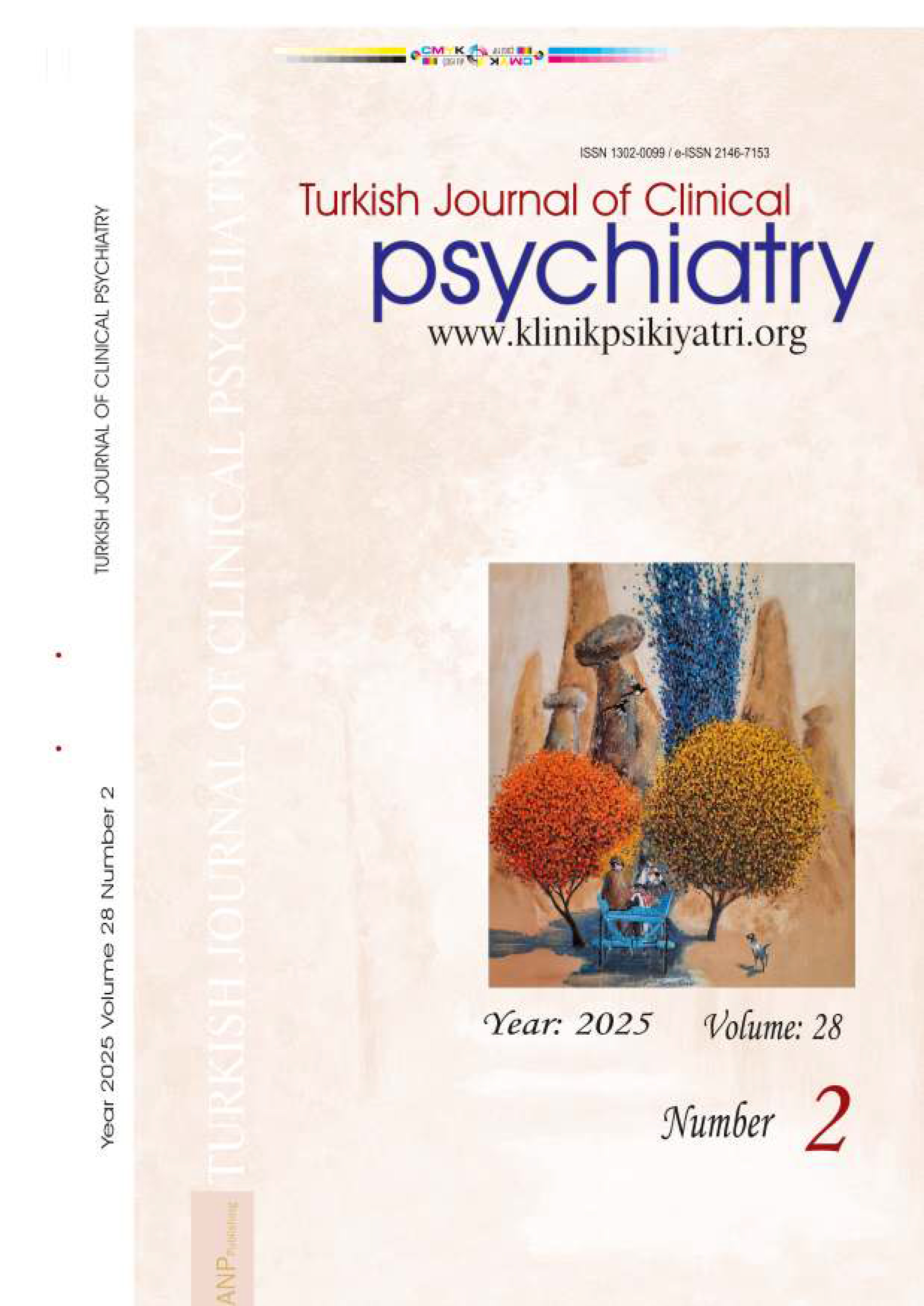





Volume: 12 Issue: 3 - 2009
| RESEARCH ARTICLE | |
| 1. | The Validity and the Reliliability of Suicide Probability Scale (SPS) in Clinical Sample Zehra Atlı, Mehmet Eskin, Çiğdem Dereboy Pages 111 - 124 Objectives: The aim of the study was to evaluate the validity and the realibility of Suicide Probability Scale (SPS) developed by Cull and Gill to aid in the assessment of suicide risk in adolescent and adults, in clinical sample. Method: 428 subjects (272 women, 156 men) were included in the study. Patients (n=217) were recruited from inpatients and outpatients followed up in the clinic of a university hospital. Controls (n = 211) were recruited from the general population. All the subjects gave informed consent. Confirmatory factor analysis (CFA), Cronbach Reliability analsis, Pearson moment products correlation coefficients and t-test were used to analyze the data. Results: Confirmatory factor analysis supported the validity of factor structure of SPS which was obtained in the original study. The results of Cronbach Realibility analysis demostrated high internal consistency and split-half reliabilities confirmed the reliability of the scale. The total score of the SPS were correlated significantly with the scales of Beck Depression Scale, Beck Hopelessness Scale and Rosenberg Self-Esteem Scale scores as expected. Also the findings showed that SPS differentiated suicide attempters with controls and also the groups which have suicide ideation with which do not. The cut off point was 110 for both psychiatric patients and controls. Conclusion: The findings showed SPS is a valid and reliable measure for clinical samples in Turkey. |
| 2. | Risk Factors Associated with Substance Use Among Dicle University Students Murat Yalçın, Altan Eşsizoğlu, Hasan Akkoç, Aziz Yaşan, Faruk Gürgen Pages 125 - 133 Objectives: Determination of the prevalence of substance use at least once during life-time, and risk factors associated with substance use among university students, was aimed in the present study. Method: Data obtained via socio-demographic data forms and substance use information forms, from 2040 students attending Dicle University was evaluated with chi- square, t-test and binary logistic regression analysis. Results: It was determined that 123 of the participants (6.03%) have used substance at least once during their life-time. Males compared to females, people who have job compared to jobless, student who have poor academic performance compared to those with average or good academic performance, people without a religious belief compared to people with religious belief, people with a history of suicide attempt compared to people with no suicide attempt, people who defined their families as conservative compared to people who defined their families as liberal had statistically significantly higher rates of substance use at least once during life-time. Being male, living with the family, having job, having divorced parents or separated parents, smoking, using alcohol, having a history of suicide attempt and not having a religious belief, were risk factors for substance use at least once during life-time. Conclusion: Studies on substance use are crucial regarding the changes in prevalence with time. However, in the attempts to prevent substance use, information concerning the factors which increase the risk of substance use is warranted. Key Words: Substance usage, university student, risk factor. |
| 3. | Eight Week Follow-up for Autism Symptoms and Comorbid Features of Autistic Children Under Special Education and Medication Seher Akbaş, Koray Karabekiroğlu, Ozan Pazvantoğlu Pages 134 - 140 vObjectives: In eight-week period, we aimed to explore symptom distribution changes and comorbid features of autistic children. Methods: Children and their parents were assessd in psychiatry clinic in terms of DSM-IV-TR diagnostic criteria. Mothers completed Autistic Behavior Checlist (AuBC) and Aberrant Behavior Checklist (ABC) in the first session. Mothers continued completing ABC twice every month. Sociodemographic variables, treatment and progress history of the disorder before and after the first session were obtained from the hospital files. Results: The autictic children (n: 27) were 4.51 ±1.62 years-old on average. Mean score of AuBC was 70.33±16.80. Attention deficit hyperactivity problems were appearantly higher (%70.4). During the first session, AuBC scores did not reveal significant difference whether or not the child received special education and/or medication (p>0.05). After eight-week special education plus drug therapy, ABC scores showed significant improvement in stereotypies (p=0.003) and hyperactivity (p: 0.015) subscores. Conclusions: The results reveal that attention deficit hyperactivity problems highly co-occur in autism and special education plus medication therapy particularly target stereotypies and hyperactivity symptoms. While different types of treatments have differential effect on different symptom clusters, in autism management we need both a detailed exploration of comorbid disorders and assessment of differential effects of treatments on different symptom profiles. |
| CASE REPORT | |
| 4. | Children and Adolescents as Sexual Offenders: Case Series Zeynep Göker, Evrim Aktepe, Selma Tural Hesapçıoğlu, Sema Tanrıöver Kandil Pages 141 - 146 Sexual violence occurs throughout the world and it has a profound impact on physical or mental health. Conservative estimates indicate that between 15% and 20% of all sexual offenses are committed by youth younger than 18. Despite there are studies for adult sex offenders, there is insufficient investigation into the characteristics of juvenile sexual perpetrators. Juvenile perpetrators constitute the part of the all sexual offenses. Past research has shown that some adult sexual perpetrators were sexual offender when she/or he was child or adolescent. Therefore if this cases evaluate for sexual offence in child or adolescent period, the behavior of sexual offence is impeded. The aim of this study was to assess 12 juvenile sex offenders and to evaluate their sociodemographic features between 2005 to 2007 at seen in our department. In our series, the average age of perpetrators was 13.5 years of age, the majority of them were male, the majority of the victims were 6 years old. The most offence type was molestation. The most psychiatric disorder was conduct disorder. In mothers there was mood disorders, in fathers there was alcohol dependency. The most cases had lower socieconomic level and lower parent educational status. Besides the forensic process, treatment and intervention programs for juvenile perpetrators may benefit to understand the nature of sexual deliquency behavior. |
| 5. | A Case Report of Factitious Disorder with Osteomyelitis Symptomatology and Chronic Pain Selda Şahin, Burhanettin Kaya Pages 147 - 152 Factitious Disorder (FD) is characterized by physical or psychological symptoms that are intentionally produced or feigned in order to assume the sick role. External incentives for the behaviour are absent. The patients with this syndrome may visit several hospitals feigning acute, usually spectacular illnesses. They may undergo multiple dangerous operations for diagnostic and therapeutic reasons. Because FD's secretive nature thwarts traditional epidemiological research, the incidence and prevalence of FD with predominantly physical symptoms are unknown and case series are an invaluable data source for it. In the presenting case presence of the following factors raised the possibility that the patient has factitious disorder with physical symptoms according to DSM IV-TR criteria: no change or fluctuation of the course of the "illness" despite treatment, to be disposed to get medical help, prone to explain the symptoms, long medical record with multiple admissions at various hospitals, willing to undergo painful or risky tests and operations. The goal of the physician is early recognition of the psychiatric condition. A high index of suspicion is needed for correct diagnosis and care. Early detection and treatment of the cases is essential to prevent the risk of harm. However, when FD is missed or untreated, it can become a chronic syndrome that is expensive and potentially dangerous. In literature, no clearly effective treatments are present and it is emphasized that the prognosis is bad. |










